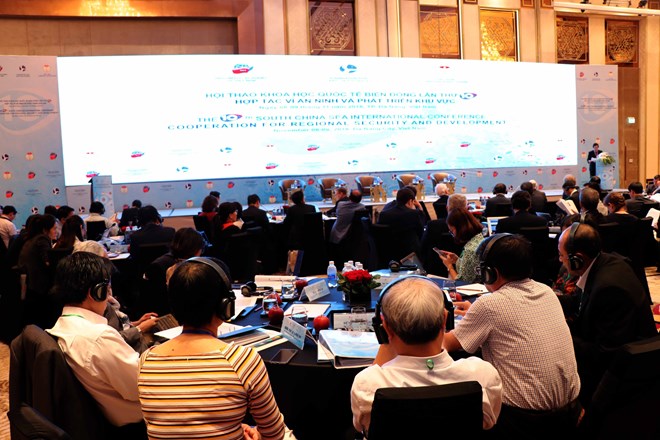Ways for Regional Security and Development discussed
The 10th East Sea International Conference, themed ‘Cooperation for Regional Security and Development’, took place in Da Nang on 8 and 9 November, with the participations of over 250 domestic and foreign scholars, academics, and diplomats in total.
 |
| The 10th East Sea International Conference in progress |
Jointly held by the Diplomatic Academy of Viet Nam (DAV), the Foundation for East Sea Studies (FESS), and the Viet Nam Lawyers’ Association (VLA), the event aimed at reviewing the latest developments, analysing strategic plans, identifying the drivers behind tension and stability, and exploring different avenues for conflict management and resolution in the East Sea region.
Marking the 10th anniversary of the inauguration of the initiative, this year's conference will also move beyond an annual review to take stock of the transformations in the East Sea across many sectors over the past decade.
The event featured 8 sessions, namely East Sea: ‘the Heart of the Indo-Asia-Pacific Region’, ‘East Sea in the Spotlight: a 10-Year Recap’, ‘Evolving Claims and Positions over the East Sea: Continuities and Changes’, ‘Major Powers: Engagements or Disengagements?’, ‘The Force Build-up in the East Sea’, ‘Confidence Building, Preventative Diplomacy and Dispute Resolution’, ‘Emerging Disrupters to Maritime Order in the East Sea’ and ‘Order, and Disorder in the East Sea: Reflections’.
In his remarks at the event, DAV President Assoc. Prof. Dr. Nguyen Vu Tung, noted that the past decade has seen increased connectivity between the Pacific and Indian Oceans, featuring great impacts on politics of Asia and the world at large in the 21st century.
He said the East Sea has been a main topic of countries’ policy making, adding, “Experts can recommend joint activities among governments to improve security and promote current regional mechanisms to peacefully manage disputes and resolve the East Sea complex issues.”
Addressing the event, municipal People’s Committee Vice Chairman Ho Ky Minh remarked that Da Nang has been an important sea gateway for Viet Nam to access many countries in Northeast Asia, Southeast Asia, Indian Ocean, and Pacific Ocean.
Fully tapping its important geographical position, Da Nang has focused on promoting its marine economic development, boosting the efficient exploitation of aquatic products, tourism, mechanical engineering, and maritime transport.
It is noticeable that Da Nang has promulgated the master plan for the marine economic growth by 2020 with the aim of maximising the potentials and advantages of the coastal areas, thereby creating more breakthroughs in the socio-economic development.
Also, effective measures and activities have been in line with the country’s sustainable marine economic development strategies by 2030, with a vision to 2045.
In particular, Vice Chairman Minh noted that the current situation of the East Sea is not only a matter regarding peace and stability in the region, but also affects the material, cultural and spiritual life of over 300 million inhabitants in total living in coastal communities.
Therefore, the city leader asked the participants to analyse the situation in the East Sea. It then proposed feasible initiatives to better control the situation and build a peaceful, friendly and sustainable East Sea.
Delivering his keynote speech, Lordship Kriangsak Kittichairasee, the Judge of the International Tribunal for the Law of the Sea (ITLOS), appreciated the significance of the East Sea International Conference. He emphasised that the cooperation for peace, stability and development in the East Sea should be based on 4 components: conflict prevention, crisis management, dispute settlement, and monitoring mechanisms.
Judge Kriangsak Kittichairasee also affirmed that the basic solution to resolve the dispute is that the concerned parties should seek concrete and substantive cooperation initiatives and refrain from complicating the situation.
Although tensions have always existed, the past decade saw some positive developments, particularly when ASEAN and China started negotiations on a Code of Conduct in the East Sea in early 2018. The two sides have also launched an emergency hotline and discussed the expansion of the Code for Unplanned Encounters at Sea (CUEs). Meanwhile, some involved parties are discussing the possibility of joint exploitation and demarcation at sea.